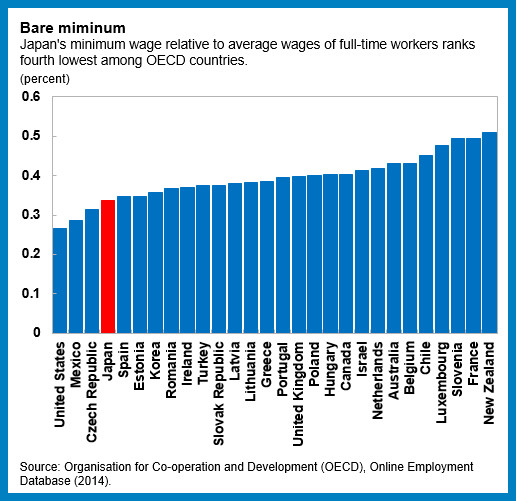Version in 日本語 (Japanese)
Japan’s minimum wage is 798 JPY ($6.52) per hour, lower than many other advanced countries, including the United States, and among the lowest relative to the average wage (see chart). For a country that needs consumers to boost spending to pull the economy out of 15 years of deflation and reinvigorate growth, a hike in wages across the board can go a long way.
This is especially the case for Japan, where there is a deep-rooted deflationary mindset and a large gap in wages and job security between regular and non-regular employees (part-timers, contract workers and temporary staff). The authorities have recognized the need for policies that stimulate wage growth to help Japan’s reflationary efforts, as well as counter the stagnation of incomes at the bottom. They have put in place plans to increase the minimum wage by 3 percent on a yearly basis, which would result in a hike from 798 PY to over 1,000 JPY per hour by the year 2023.
In our recent paper, we assess the impact of the government’s 3 percent policy on average wage growth.
Impact of the 3 percent policy
We find that an increase in minimum wages in Japan not only affects those who are working below or at the current minimum wage level—which is estimated around 10 percent of the working population—but it also increases average wage growth through various channels.
Suppose a firm now has to increase a worker’s pay from $7 to $8 an hour. In a competitive market, most business owners would lay off these workers to cut costs. But in Japan, given the current tight labor market, with record low unemployment and record high labor shortages, Japanese firms are more likely to retain these workers who are currently working below the new minimum wage. Or they might try to substitute them with more skilled workers who can command even higher wages. In either case, the effect on average wages would be positive.
Our research further explains this outcome, by looking at data for seventeen years (from 1997 to 2014), and confirms that the planned 3 percent policy would result in an additional 0.5 percent increase in average wages per year.
Complementary policies needed
While an additional 0.5 percent per year would be a significant boost, it would still fall short of what Japan needs to escape deflation. Given the Bank of Japan’s inflation target of 2 percent, and assuming productivity growth of 1 percent, wages would need to grow by at least 3 percent to have an impact.
Our analysis therefore suggests that while the increase in minimum wage policy announced by the authorities is helpful in stimulating wage growth, it should be complemented by higher public wage increases and stronger inducements to raise private wages.
Still, these income policies alone are unlikely to revitalize the economy. Japan needs structural reforms together with an appropriate monetary and fiscal policy mix—part of what the IMF has dubbed the “reload” package. In this regard, measures to reduce labor market duality of regular and non-regular workers and give more bargaining power to workers would be key. In addition, to take full advantage of the effect of wage increases, policymakers need to remove remaining distortions in the tax and social security system that discourage full time work, mostly of women.
The encouraging thing is that all these issues are on the table for discussion. We hope that the authorities will move on these with the same resolve with which they are implementing their minimum wage plan.







